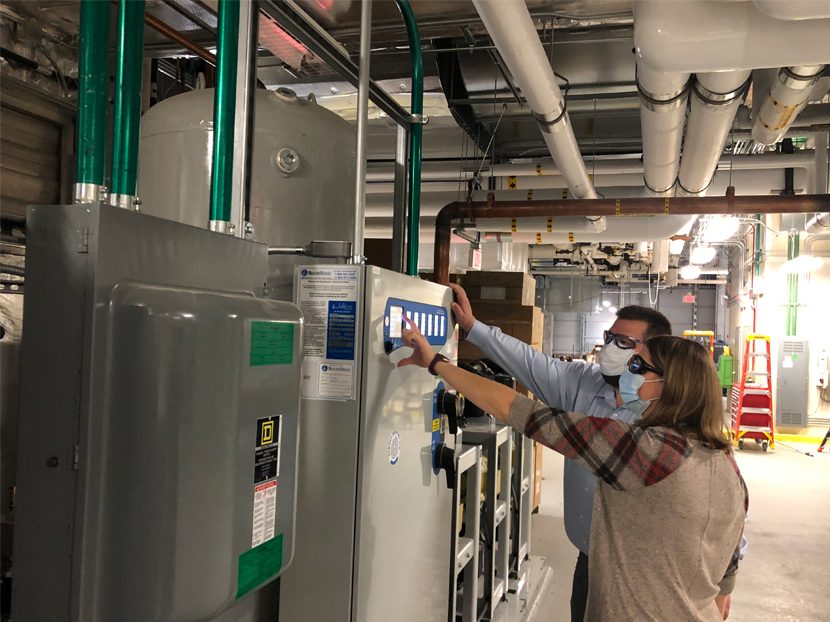A New Perspective on Campus Infrastructure
I hope hearing this story will make us all more thoughtful engineers; people’s lives depend on it.

On Nov. 18, 2020, Froedtert Health, Wisconsin’s largest Level 1 trauma hospital, took its medical air system from one that was at capacity and included code-required redundancy to one with increased capacity, increased redundancy and a level of resiliency that is very impressive. The planning for this campus infrastructure upgrade, which was executed by implementing a multivalved, multiphased cross-connect, took more than 10 years to execute and many important little steps along the way.
I recently sat down with three people (via Zoom) who were key stakeholders behind those little steps. When you talk to them, you quickly realize that the leader of this effort is Lou Moseler, a project manager for the Enterprise Facilities Services group at Froedtert Health.
When you meet Lou for the first time, you somehow leave the conversation thinking, “Have I been friends with Lou from another life?” He treats you as if you’re the most important person in his life, and he always has this big smile on his face. You know he loves what he does for a living.
In 2003, Lou, who worked for a local plumbing contractor out of Kenosha, found himself at the hospital for different reasons — his baby girl had been born 13 weeks early and was on life support. She was born at Froedtert and transferred to Children’s Hospital shortly after birth.
“That was the moment I realized why medical gas infrastructure was so important,” Moseler says. “The medical air that my new daughter was relying on had given me a new appreciation for the work we do on medical gas systems.”
I’m giving you some insight into who Lou is because it's critical to this infrastructure project's success and captures why it was important for him to be the one behind it.
From that point on, whenever Lou was working on the campus where his daughter was delivered and he saw a potential upgrade for the system or an opportunity to plan ahead, he brought it to the engineering and ownership teams. I was the plumbing engineer on four projects for the hospital, with Lou as the early trade partner. I’m not ashamed to admit that he knew more about the plumbing infrastructure than I did.
Lou has most of the more than 3 million square feet of the campus plumbing system somehow memorized in his head. I know you think I’m joking, but it seems like he does. Lou brought ideas to me about improvements he thought we should make on every one of those projects. Whether it was a better way to route our systems to avoid disturbing spaces or adding in a valve to make future work on campus more successful, he never missed the opportunity to leave a project better than he found it.
And that’s what brings us to Froedtert’s latest campus infrastructure upgrade. Lou can take you through the campus where he and the hospital’s engineering consultants made improvements over the last 10 years. I won’t take a deep dive into each of those efforts but know this — without those improvements, Froedtert wouldn’t be where it is today.
For this Q&A, I’ve also included Jill Imig, head of the Mechanical Engineering Department at HGA Architects and Engineers, and Scott Altenberger, lead project manager, Enterprise Facility Services for Froedtert Health.
Cory Powers: When did the campus first start thinking about the need for this cross-connection project?
Lou Moseler: That happened during a major addition on campus. Scott realized that if Froedtert kept building, it would not have the redundancy on campus that it needed. I say this because, at the time, I was still working for a local plumbing contractor.
With this realization, another medical air plant was added, which essentially gave Froedtert one medical air plant on each end of the hospital campus. This construction happened in 2016. After that, it was only a matter of time before we could make this one large, interconnected campus for medical air and medical vacuum.
CP: What was the major weaknesses in the system before the tie-over?
LM: Pre-COVID-19, it was nice to have, but when we saw the consumption values of medical air from our COVID patients, we knew we wanted and needed the added capacity and redundancy in the medical air system. We also took advantage of the effort to set up the medical vacuum for a future plant.
CP: How long did it take to put the plan together?
LM: This was the result of several years of project-specific work, where the team ultimately knew the end goal of having an interconnected campus. Biting this off as one package would have been impossible. The disruption to the hospital and the costs would have been overwhelming.
CP: How do you plan for projects like this?
Scott Altenberger: It really started with need. The team asked how do we match up against the industry expectations on the campus-wide demand versus capacity? After this effort, we were able to use the master plan to show project leadership the value of infrastructure projects.
In addition, the COVID pandemic gave us a second push to take this system from something that met code to a whole new level of resiliency. Building growth started this effort; we just took advantage of the timing and used the opportunity to get the systems at a place where we now have a robust medical air system for our campus.
CP: Lou, being a former plumber and now working for a client, what pressure do you feel when doing something of this nature in a live hospital?
LM: I feel more pressure now being on the ownership side. I have a better understanding and magnitude of what we are doing here. You realize how you are affecting care and how many people are truly impacted by these shutdowns. It is hard for me not to jump in there and turn those valves and make those connections. I have to now put my dedication into planning the work and working the plan.
Being on the campus for more than 10 years before working directly for Froedtert helped. The whole concept of value engineering really challenged this, but adding those valves on individual projects has made this possible.
CP: What lessons did you learn from this infrastructure project that you can apply to future hospital designs?
Jill Imig: When I first started out in my career, I was told that good practice in medical gas design is to use 3/4 inches for any gas that is more than one outlet. I certainly witnessed that a small increase in a simple pipe size can make a huge difference when it comes to high-demand pandemics such as this.
There were so many opportunities to learn from this project and the pandemic as a whole; I could go on for days! Overall, I think the biggest thing I learned is how big of a part the respiratory therapists play in the care of every patient. Every facility has different tools at its disposal, so it was interesting to learn how they can manipulate what is on hand to aid each patient who comes through the facility.
They were a critical piece in solving the infrastructure puzzle; without the respiratory therapists' input, our calculations don’t have the accurate assumptions that would make Froedtert and HGA comfortable.
CP: Who were the players that needed to be involved in this project?
JI: Froedtert executive leadership, engineering consultants (these teams were critical), trusted contractors, and all the project teams over the past 10 years that worked together and trusted the construction teams and the value of these cross-overs: in-house facilities team, Froedtert respiratory therapy team, and medical gas equipment service technicians.
CP: Scott, what was it like to explain this infrastructure project to your executive leadership team?
SA: You sell these infrastructure projects as a must-do, given the regulatory component of it. The fear of failure can be motivational. When leadership asks why, you can show them the calculations that reflect how we meet NFPA and industry standards.
If a project is needed because of a code deficiency, we just do it. We leverage subject matter experts such as Lou to show why something needs to be ranked as a must-do. With time and effort, we gained the trust of the leadership team; we are demonstrating that we are making future growth easier on the campus.
CP: What did this project do for the campus medical air and vacuum infrastructure?
LM: Redundancy and the ability to lessen disruption on future projects. Resiliency in the system is much stronger because of COVID-19. Under nonpandemic conditions, we will have much more freedom.
CP: If you could do it all over again, what would you do differently?
LM: As a contractor, I could only do what I was allowed to do. In my case, I was fortunate to have worked with great Froedtert project managers and great engineering firms. My voice was heard on many occasions.
As a representative of the owner, I will gladly listen to ideas from contractors, engineers and our staff. The only bad idea is the one never spoken of. There may be better, different or more cost-effective ideas, but rarely a bad idea.
CP: Did the pandemic help with the timing of this effort?
LM: Yes, the potential for the pandemic to max out our med air plant in a portion of our project pushed us to execute our plan.
CP: Jill, what was it like collaborating with a client on this project?
JI: This collaboration took me through the gamut of emotions — it was exhausting, fun and challenging. I am thankful that I have such a great relationship with Lou and Scott; we were able to set our goals at the beginning of the project and challenge every part of the logic along the way. It was critical for us to remain on the same page and stay in constant communication. COVID surge flows changed daily; it was essential to remain nimble.
CP: What’s the driving force behind a project like this: the fear of failure or the comfort of resiliency?
SA: It starts with the fear of failure, but I have to tell you, we are sleeping much better at night with the new cross-connect in place. We’ve managed to educate our leadership team on the “why” for these projects through constructive conversations. The pandemic gave us an opportunity for growth; we obtained a better system and product at the end of the day for our patients.
When you listen to the passion these professionals bring to projects such as this, you get the sense that they really care about what they’re doing. On the call, Scott and I were trying to get Lou to explain to us why we don’t always get the same level of passion from project teams as he exhibited for so many years on this campus. That’s when Lou told us about his 73-day NICU introduction to being a father and his new appreciation for reliable medical gas infrastructure that saved his daughter’s life.
When thinking about future projects, Lou explains that those new projects will be completed with limited air or vacuum disruptions. This is a dream scenario for a facilities manager. He went on to preach to all the engineers reading this column: “When engineers work on hospitals, you need to help the campus plan for the future. If you take a future valve, you should leave a future valve.”
Listening to Lou makes me realize that perspective is so important. I hope hearing this story will make us all more thoughtful engineers; people’s lives depend on it.
A special thanks to all the project managers, maintenance and trade mechanics and everyone at Froedtert Health who was involved in this effort.





